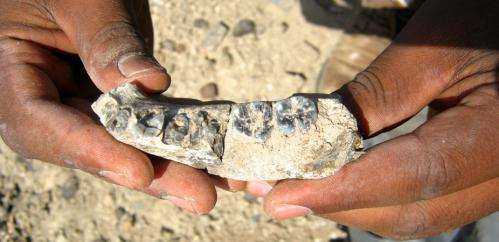Age of jawbones mean the origins of humans just got older

There's plenty of excitement this month amid reports that scientists had identified the "dawn of humankind" in the Rift Valley of Ethiopia.
With reports this discovery of a jawbone could "rewrite the history of human evolution" you might well imagine, my hyperbole detector became instantly aroused.
Putting aside the hype that always accompanies discoveries in human origins research, this turned out to be, refreshingly, an important discovery that dramatically shifts debate on the beginnings of the human genus.
In fact, by uncanny coincidence I assume, two scientific studies bearing on this same issue were published in Nature and Science within a day of each other.
A handy find
In Nature we learnt from Fred Spoor and his team that the type fossil for the early species Homo habilis (the "handy man"), which in this case is a lower jaw dubbed Olduvai Hominid 7 (OH7), could be repaired and its anatomy made more accurate using a 3D-CT-scanning approach.
The fossils belonging to Homo habilis were mostly found at Olduvai Gorge in Tanzania by Louis and Mary Leakey during the 1950s and 1960s, with some similar looking bones found a couple of decades earlier in caves near Johannesburg by Robert Broom and John Robinson.
Spoor's study found that OH7 was a lot more primitive than had been thought since it was described – and named the "handy man" by Louis Leakey, Phillip Tobias and John Napier more than 50 years ago.
Spoor and his colleagues compared this roughly 1.8 million year old jawbone to other examples of primitive Homo, living humans and other apes. They did this to gauge just how variable these early pre-humans may have been, and whether they might sample multiple evolutionary lines, or species.
And they clearly identified several early species of Homo going back to before 2.3 million years ago, with some of them (not OH7 though) being very modern in the structure of their face and jaws, or remarkably human-like.
Pushing Homo back in time
The Science study published by Brian Villmoare and colleagues showed the origin of Homo could now been pushed back by almost half a million years to at least 2.8 million years ago, with the discovery of a new jaw at Ledi-Geraru in the Rift Valley of Ethiopia during fieldwork in January 2013.
This fossil is a real beauty! It's largely complete, and overall its physical traits are surprisingly rather modern. The jawbone is not very rugged and fine details of the tooth crowns and pattern of wear on the teeth are rather precocious, hinting at features seen in much later Homo species.
If you're a human evolution buff like I am, then this is the kind of discovery that truly gets the heart racing. It shifts the ground dramatically and excitingly overnight.
Why? Well, first of all, we simply don't have that many fossils from the crucial temporal window of 2-3 million years old, especially in East Africa.
Second, the human genus is now getting dangerously close to 3 million years old, much, much, older than current scientific models or textbooks state.
Third, we can largely throw the popular models of climate change used to explain the beginnings of Homo out the window: the Ledi-Geraru jaw is too old to be explained by the onset of global cooling or a shift to more open vegetation in Africa. But it may coincide with a regionally arid ecology.
Fourth, despite the record breaking hyperbole that surrounded discoveries such as Australopithecus sediba, this South African species dated around 1.98 million years old is clearly in the wrong place at the wrong time to be the ancestor of Homo, as I stated just two years ago.
The Ledi-Geraru fossil also sidelines the other chief contender for Homo ancestry, Australopithecus garhi. This is a 2.5 million year old species also found in the Ethiopian Rift, on the grounds of its younger age and different anatomy.
The Homo-like features of the bones of sediba and garhi do tell us something important though: there was a lot of diversity in these early pre-humans and that some of their features must have evolved in parallel with Homo probably owing to the species facing similar ecological challenges.
Finally, the new study of OH7 and the discovery of the Ledi-Geraru jaw together show there was, as many of us in the business have been arguing for a long time, numerous species of Homo and Australopithecus in Africa in the period 1 to 3 million years ago.
Just 18 months ago I again found myself criticising another glib study involving a new fossil from Dmanisi in Georgia claiming that more than a dozen species of Homo should be sunk into a single evolutionary line leading to living people.
It's amazing to think that studies like this and the interpretations of the sediba discovery can be shown to be incorrect so quickly. But, then again, there is often a lot more at play than just the science.
Source: The Conversation
This story is published courtesy of The Conversation (under Creative Commons-Attribution/No derivatives).
![]()





















